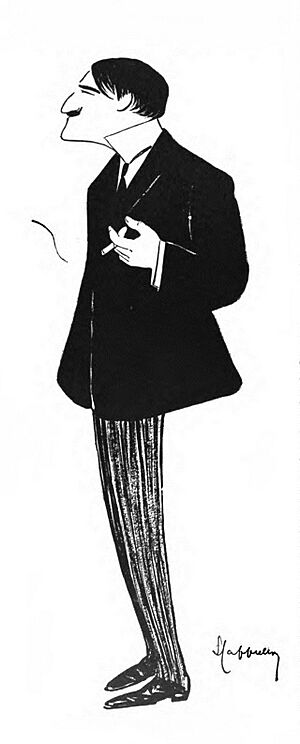Leonetto Cappiello facts for kids
Leonetto Cappiello (born April 9, 1875 – died February 2, 1942) was a talented Italian and French poster art designer and painter. He lived and worked mostly in Paris, France. Today, many people call him 'the father of modern advertising'. This is because he changed how posters looked. Early advertising posters often looked like paintings. But Cappiello used bold figures that seemed to jump out from dark backgrounds. This was a new and exciting style for posters.
Contents
About Leonetto Cappiello
Leonetto Cappiello was born in Livorno, a city in Tuscany, Italy. He later passed away in Cannes, France.
Cappiello did not go to art school. He learned art on his own. His first art show was in 1892. One of his paintings was shown at a museum in Florence. You can see some of his paintings today in the Museo Civico Giovanni Fattori in Livorno.
Cappiello's Caricatures
Cappiello started his career by drawing funny pictures called caricatures. These drawings made fun of people or things in a clever way. He drew for many magazines like Le Rire and L'Assiette au Beurre.
His first book of caricatures, called Lanterna Magica, came out in 1896. In 1898, he moved to Paris. There, his caricatures were printed in Le Rire for the first time.
In 1902, a book of his caricatures called Gens du Monde was published. It showed 'people of high society'. The next year, another book, Le Théâtre de Cappiello, came out. It had drawings about the theater.
Cappiello slowly started to draw fewer caricatures. He became more interested in designing posters. In 1905, a final book of his drawings, 70 Dessins de Cappiello, was released. It included black and white prints and some color images. The color was added by hand using stencils. This was a common way to add color cheaply back then.
Cappiello became famous during a time when posters were very popular. His designs were very different from other artists. His first poster, for a newspaper called Frou-Frou, was made in 1899.
Working with Vercasson
Cappiello's poster career really took off in 1900. He signed a contract with a printer named Pierre Vercasson. Back then, printers often acted like agents for artists. They would find clients and give artists work.
Vercasson wanted his posters to be bright and colorful. He wanted them to stand out in Paris. He knew Cappiello's work and thought he was the perfect artist. Their agreement was simple: Vercasson would find clients and tell Cappiello what they needed. Cappiello would then create a sketch. For each sketch, he earned 500 francs, which was a good amount of money.
Once a client liked the sketch, Cappiello would make a full-size design. This design was then put onto a special stone for printing.
In 1901, Cappiello married Suzanne Meyer. His brother Oreste married Camille, who was the sister of painter Alfredo Müller.
Between 1901 and 1914, Cappiello made hundreds of posters. His style changed poster design forever. He made posters that fit the faster pace of the 20th century. During this time, he still drew some caricatures. When World War I started, Cappiello worked as an interpreter in Italy.
Working with Devambez
After World War I, Cappiello went back to making posters. In 1918, he met with Devambez, a publisher in Paris. Three years later, he signed a special contract with them. For Devambez, he designed many famous posters. These included ads for Kub, Campari, Parapluie Revel, Pirelli, and Chocolat Klaus. He also designed posters for the famous entertainer Mistinguett at the Casino de Paris.
Unlike Vercasson, Devambez did not have its own printing house. They had posters printed at other large companies. Devambez focused on finding new clients all over Europe. This helped spread Cappiello's amazing work across the continent. He worked with Devambez until 1936.
Cappiello's Legacy
During his career, Leonetto Cappiello created more than 530 advertising posters. Even today, his original posters are still very popular. People collect them, and they are sold at auctions and by art dealers around the world.
Selected Posters
-
Sous Vetements Hygieniques (underclothes ad for Docteur Rasurel, 1906)
-
Cognac Pellisson (cognac ad, 1907)
-
Thermogène (ad for a cough and rheumatism remedy, 1909)
-
Uricure (ad for a rheumatism, gout and arthritis remedy, 1910)
-
Aigua de Vilajuïga (Spanish mineral water ad, 1910)
-
Maraliment (ad for a brand of seaweed soup, 1920)
-
Cafe Martin (ad for a coffee company in Paris, 1921)
-
La Victoria Arduino (espresso ad, 1922)
-
Contratto (liquor ad, 1922)
-
Parapluie Revel (ad for a luxury umbrella manufacturer Revel, Paris, 1922)
-
Chłopiec na zebrze, (Warsaw, 1926)
-
La Rose Jacqueminot, Coty, (perfume ad, 1904)
See also
 In Spanish: Leonetto Cappiello para niños
In Spanish: Leonetto Cappiello para niños

















